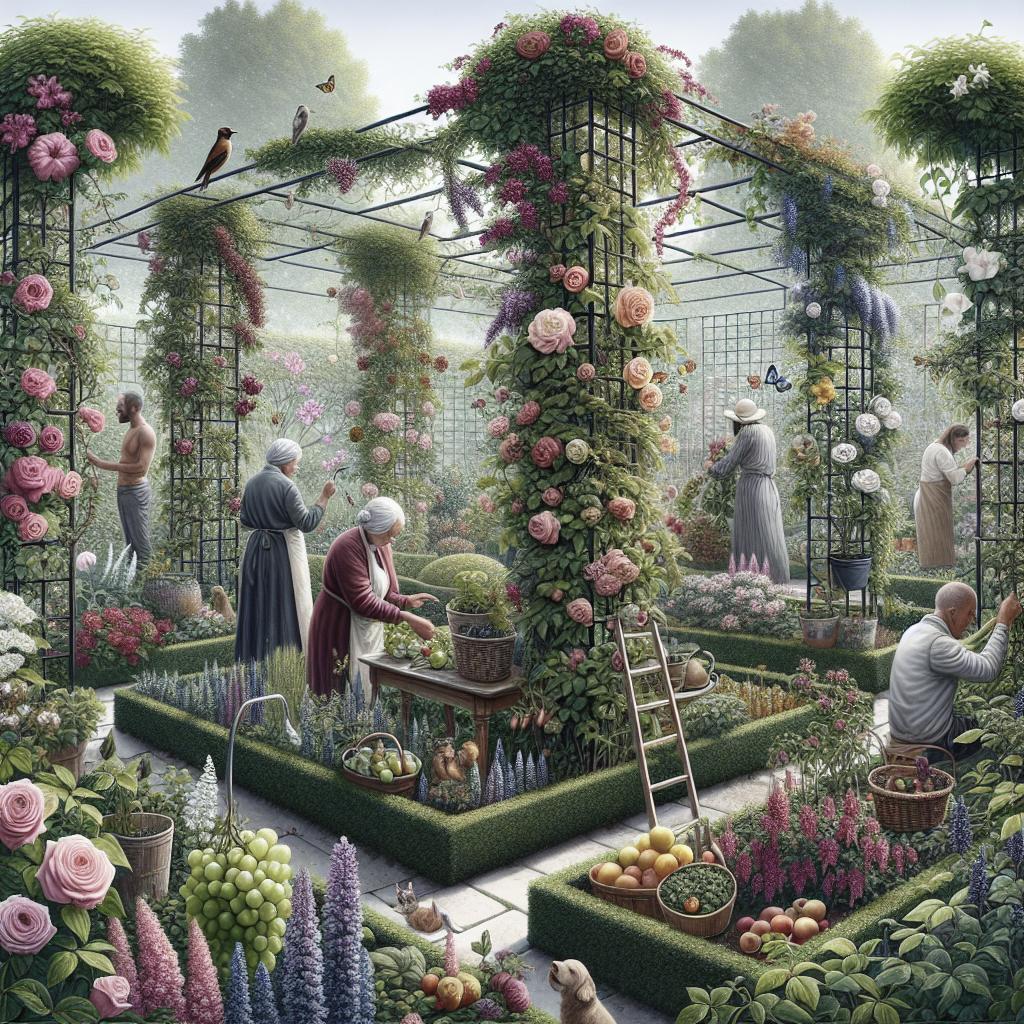“`html
Ten Best Climbing Plants for Your Garden Trellis
Welcome to your essential guide on the best climbing plants for community garden trellises! Whether you’re looking to maximize vertical space or simply add some lush greenery to your garden, trellises are an excellent solution. We’ll go through ten winning plant choices that can thrive on your trellis and elevate your gardening experience. From beans to chayote, we’ll explore the unique benefits of each plant, discuss types of garden trellises, and provide tips on supporting plant growth. Along the way, we’ll also discuss the benefits of trellising your vegetables and offer related resources to enhance your gardening skills.
Beans
Beans are a classic choice for climbing plants. They’re highly productive and can easily cover a trellis with their vibrant green vines. Varieties like pole beans or runner beans grow well on trellises and offer benefits such as nitrogen-fixing, which enriches the soil. They also provide a continual harvest throughout the growing season, making them a favorite among gardeners.
If you’re looking to add a touch of color, varieties such as Scarlet Runner beans bloom with attractive red flowers. They are also quite versatile and can be used in both fresh and dried forms.
Malabar Spinach
Unlike traditional spinach, Malabar spinach thrives in hot weather, making it a perfect choice for summer trellises. It’s not only a hardy plant but also a nutritious one, rich in vitamins A, C, and Calcium. The vine grows rapidly and can reach up to 10 feet, making it an excellent choice for creating a lush and leafy backdrop.
The flavorful, slightly mucilaginous leaves can be used in a variety of culinary dishes, from salads to stir-fries. This makes Malabar spinach a functional yet aesthetically pleasing addition to any community garden trellis.
Snow Peas
Snow peas are another excellent climbing plant for trellises. They thrive in cooler weather and can be planted in early spring or fall. Their delicate vines can easily scale a trellis, producing sweet and tender pods that are perfect for fresh eating or adding to stir-fries.
Besides their culinary benefits, snow pea plants also enrich the soil with nitrogen, thanks to their symbiotic relationship with soil bacteria. This makes them a valuable addition to a community garden, improving soil health for future crops.
Luffa Gourds
Luffa Gourds are a unique and versatile option for a garden trellis. While they require a longer growing season, they reward gardeners with both edible young fruits and mature gourds that can be dried and used as natural sponges.
The vines can grow quite large, so they require sturdy support. However, their beautiful yellow flowers and dual-purpose harvest make them a fantastic choice for sustainability-minded gardeners looking to get the most out of their trellis space.
Peppers
While not traditionally thought of as a climbing plant, certain varieties of peppers, especially the vine-like Aji Amarillo, can do well on trellises. These peppers can add a vibrant splash of color with their glossy fruits ranging from green to bright red or orange.
Trellising peppers can help in keeping the plant upright, ensuring better airflow and reducing the risk of diseases. It also makes harvesting easier and more efficient.
Cucumbers
Cucumbers are a staple in many gardens, and they thrive when grown vertically on a trellis. This method not only saves space but also helps produce straighter, cleaner cucumbers by keeping them off the ground.
With varieties ranging from slicing cucumbers to pickling ones, these plants are versatile and productive. Trellising also makes it easier to spot and pick ripe cucumbers, increasing your harvest efficiency.
Tomatoes
Tomatoes are a favorite for many gardeners, and indeterminate varieties (those that continue to grow and produce fruit throughout the season) are particularly well-suited for trellises. The support helps keep the tomatoes off the ground, reducing the risk of rot and making them easier to harvest.
Using a trellis allows for better air circulation around the plants, which can help prevent common diseases like blight. Plus, it makes for an impressive vertical display in any garden setting.
Cucamelons
Cucamelons, also known as Mexican Sour Gherkins, are an intriguing and delightful addition to any garden trellis. These tiny fruits look like mini watermelons and have a tangy, cucumber-like taste. The vines require sturdy support but can create a dense, attractive covering on the trellis.
Not only are cucamelons fun to grow and harvest, but they are also relatively pest-resistant and can provide a unique conversation piece for your community garden.
Winter Squash
Winter squash varieties such as butternut and acorn squash can benefit immensely from trellising. Growing these plants vertically helps save space and promotes healthier fruit by keeping it off the ground.
Given their weight, it’s important to ensure your trellis is strong enough to support the fruits. But the effort is worth it for the resulting high yields of nutritious and long-storing vegetable options.
Chayote
Chayote, also known as vegetable pear, is a vigorous climbing plant that grows well on trellises. This perennial plant produces pear-shaped fruits used in various culinary dishes worldwide. Its rapid growth means it can quickly cover a substantial trellis.
The plant’s large leaves and sprawling vines can also provide ample shade, making it a functional yet aesthetically pleasing choice for any community garden trellis.
Types of Garden Trellis
Arched Trellis (Zn-Al-Mg Steel) For 8ft.L / For 6.5ft.L
An arched trellis, especially one constructed from hardy Zn-Al-Mg steel, provides not just a functional support structure but also an eye-catching garden feature. Suitable for both a length of 8 feet and 6.5 feet, these trellises offer versatility for different garden sizes.
The strength and durability of the material mean that you can confidently grow heavier plants such as winter squash and luffa gourds. The arched design also adds an element of sophistication and can create a beautiful entryway or focal point in your community garden.
Attractive Arched Design
The arched design of trellises provides a blend of form and function that is pleasing to the eye. Whether covered in the lush greens of Malabar spinach or the colorful blooms of runner beans, an arched trellis can bring an element of elegance to a garden space.
Additionally, the raised height of the arch creates an inviting passageway and can serve as a natural pergola, enhancing the garden’s overall aesthetic appeal and creating a welcoming environment for garden visitors.
Supporting Plant Growth
Trellising supports plant growth by ensuring that climbing plants have the structure they need to thrive. It helps in minimizing plant stress and allows for better light exposure, which can result in healthier and more productive plants.
Moreover, support structures like trellises enable better air circulation around the plants, reducing the risk of fungal diseases. This aspect is particularly beneficial for plants like tomatoes and cucumbers, which are prone to blight and mildew.
Benefits of Trellising Your Vegetables
Trellising offers numerous benefits, not just for the plants but also for the gardeners. It maximizes garden space, making it possible to grow more in less area. Vertical gardening can thus be extremely beneficial in an urban or community garden setting where space is often limited.
Additionally, trellised plants are easier to harvest and manage. It reduces the need for bending over, making garden maintenance less strenuous. The improved air circulation also results in fewer pest problems and healthier plants, leading to a more bountiful harvest.
Get Growing!
Now that you have an array of climbing plants and trellis ideas, it’s time to get growing! Choose the plants that best fit your garden’s climate and needs, and start constructing those trellises. With a bit of planning and effort, you can transform your community garden into a vertical paradise brimming with healthy, productive plants.
Related Posts
What to Plant in August
Everything You Need to Know About Filling Garden Beds
What to Plant in July
Leave a Comment
Summary of Main Points
| Plant | Benefits |
|---|---|
| Beans | High productivity, nitrogen-fixing, colorful varieties. |
| Malabar Spinach | Thrives in heat, nutritious, rapid growth. |
| Snow Peas | Suits cooler weather, enriches soil, tender pods. |
| Luffa Gourds | Dual-purpose (edible and natural sponges), attractive flowers. |
| Peppers | Vertical growth support, vibrant colors, better airflow. |
| Cucumbers | Saves space, cleaner fruits, efficient harvesting. |
| Tomatoes | Better air circulation, easier harvest, healthy fruits. |
| Cucamelons | Unique appearance, pest-resistant, productive. |
| Winter Squash | Saves space, healthy fruits, high yields. |
| Chayote | Rapid growth, versatile culinary use, large leaves for shading. |
“`


